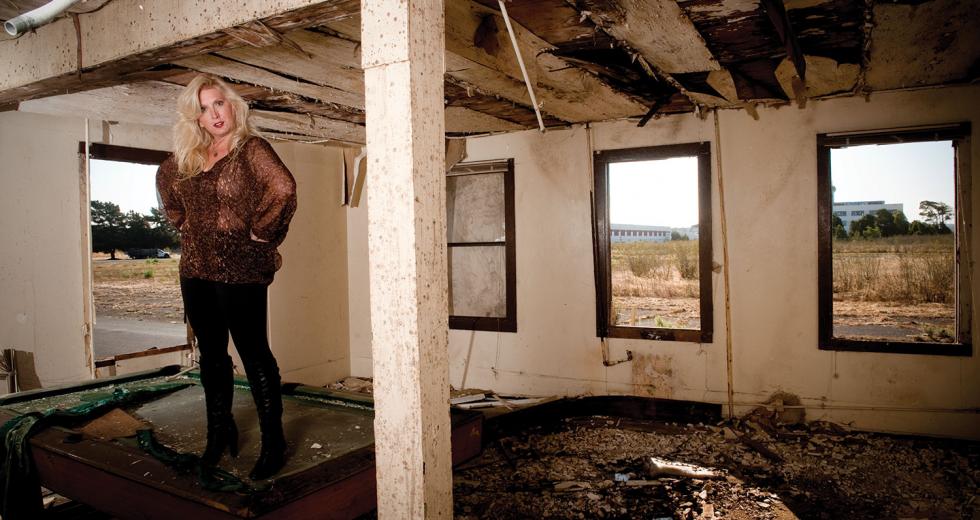Carissa Carpenter had her eye on Mare Island for the location of a state-of-the-art movie and television studio plus production company. Headed by Carpenter and studio president Howard Kazanjian, renowned producer of blockbuster films such as “Raiders of the Lost Ark” and “Star Wars: Episode VI – Return of the Jedi,” the studio aimed to be an alternative to Hollywood’s heavily booked and expensive movie sound stages.
But dreams to build a movie studio on a 157-acre island parcel about 30 miles from San Francisco and 17 miles from Napa — one of the last available large, waterfront properties in the Bay Area — have dissipated. A deal between Mare Island Studios LLC and the city of Vallejo dissolved in debate, leaving the would-be studio without a home.
“We wanted to make a home for filmmakers around the world where they were treated fairly and the politics that go on in Hollywood would be nonexistent,” says Carpenter, Mare Island Studios’ chairwoman.
Her idealistic project was the frontrunner in Vallejo after the two parties entered into an exclusive right to negotiate agreement (ERN) in December 2010. Squabbles over missed payments and unmet deadlines threatened the partnership throughout 2011, and the agreement ended without a deal.
Refusing to give up, Carpenter and her staff pled with the Vallejo City Council twice to continue working with the studio. Finally, she and attorney Robert Naylor, who works as a consultant for Mare Island Studios, met with council members separately.
Talks with City Council members Stephanie Gomes and Joanne Schivley, who espoused support for the studio project, buoyed hopes for the Mare Island Studios team in late September. Gaining their support, Carpenter hoped, would sway the rest of the council to reopen negotiations for the movie studio.
Naylor says he gave Gomes and Schivley the information for Mare Island Studios’ financial backer and tried to arrange a meeting to prove they had full project financing, but the council members didn’t bite. Gomes and Schivley couldn’t be reached for comment.
“It became apparent to us that gaining support of the majority of the City Council in the midst of an election, and given the hostility of the city management (that went) out for (a request for qualification) without consulting us, that we would be better off seeking property in another city,” says Naylor, referring to the City Council’s vote in August to open the north Mare Island parcel to new developers, asking they submit requests for qualifications (RFQ).
That move signaled to Mare Island Studios that the city was abandoning the studio project.
“The City Council decided not to extend the exclusive right to negotiate because of inactivity by Mare Island Studios,” says Annette Taylor, senior community development analyst for the city of Vallejo. “They had not provided proof of funding as of the deadline for the ERN.”
Carpenter says the studio team was not inactive during the ERN period (which ended June 14 without an extension) but had been working with the city to iron out differences in cost estimates for tearing down dilapidated Navy buildings and constructing the extensive infrastructure needed to support buildings on the soft island soil. The City Council’s decision was “unexpected and shocking,” she says.
“There were certain things they needed to come up with in order for the city to continue an exclusive right to negotiate agreement,” says Deborah Lauchner, the city’s finance director. “Part of that was they hadn’t really proved to the city that they had funding for the project.”
Carpenter says Mare Island Studios had financial backing from bankers such as Wells Fargo, Piper Jaffray & Co. and the U.K.’s Fluid Capital Group LLC. Bankers required a contract between Mare Island Studios and Vallejo to release the funding; when the City Council voted in August to open the north Mare Island parcel to new RFQs, the banks pulled the studio funding, she says.
“My bankers in the U.K. picked it up off the wire that the city was putting out a RFQ to get new developers,” Carpenter says. “They said, ‘We’re not going to give you the money because the city doesn’t know what they want. They don’t want you there.’”
Vallejo Economic Development Director Ursula Luna-Reynosa says Mare Island Studios never brought a banker to the city negotiations. The only evidence of the studio’s funding was a letter, which was not a financial commitment letter and not from a legitimate financial source, she says.
Mare Island Studios produced a letter from its finance consultant Robert Star, president of Star Global International Inc. The letter, addressed to Carpenter, states Star had secured financial commitments from both Wells Fargo and Piper Jaffray and was in talks with Fluid Capital, which was ready to commit $300 million. No further financial documents were found.
A May 24 letter from Vallejo City Manager Phil Batchelor to Carpenter confirms Mare Island Studios failed to pay an exclusive negotiation fee of $100,000 due Jan. 7 and a $200,000 surety outlined in the ERN agreement. Mare Island Studios paid the first $50,000 of the surety, which the city verified. The letter summarized requirements the studio needed to meet before June 7 to extend the ERN, including submitting a complete project description.
While city officials had the right to pull out of the ERN with Mare Island Studios in early 2011 because of missed payments and unmet goals, they continued to negotiate in hopes of reaching an agreement, says Assistant City Manager Craig Whittom, who joined Batchelor, Mayor Osby Davis and various city staff in the negotiations.
On June 14, Batchelor sent another letter to Carpenter notifying her that the studio had not met requirements of the ERN outlined in the city’s May 24 letter and that the exclusive negotiating period with Mare Island Studios would be terminated.
Naylor claims Mare Island Studios had negotiated a new lease purchase agreement (and a new payment schedule) with the city in March, after the financial markets dramatically changed from last year’s more stable conditions. The mayor and city manager made a verbal and handshake agreement to the lease purchase that would stand until it could be signed following an environmental impact report, Naylor says.
“Our position is that we negotiated a change with the city, and they went along with it and essentially bought the notion that we needed more time to arrange financing,” Naylor says.
Whittom says attorneys drew up a draft lease purchase agreement that was never signed, and neither the mayor nor the city manager agreed to it or to changing the terms of the ERN. A lease purchase agreement was produced but was not signed. The mayor and city manager could not be reached for comment.
“As part of the ERN agreement, we were discussing with Mare Island Studios a lease purchase agreement and shared drafts,” Whittom says. “Those were never executed and were never brought to the City Council for consideration, due to the lack of performance of Mare Island Studios’ financial capability.”
Vallejo Councilwoman Stephanie Gomes says she was a big fan of the movie studio project throughout the ERN and even through the RFQ process that opened development opportunities to others. At the council meeting and afterward, Gomes encouraged the Mare Island Studios team to submit its project proposal as part of the RFQ process, saying the studio would be a great asset to Vallejo.
“It would bring jobs here,” says Gomes. “It would create the need for other businesses outside the studio area, like hotels, restaurants and shops and bring other filming related business here.”
Now, it’s back to square one for Vallejo as city staff evaluate the RFQs they received from three new developers in late September. Prospective developers for the 157-acre north Mare Island parcel are LDK Solar (a China-based company with offices in Sunnyvale), pitching a 20- to 100-megawatt solar farm; and Avant Housing LLC of San Francisco, proposing a mixed-use development of industrial and commercial space.
On a separate 30-acre waterfront parcel on the island’s north end, San Francisco-based Noah’s Ark Afloat is vying to build an ark-themed amusement park. These proposals would go to the Vallejo City Council for consideration sometime in November. Luna-Reynosa says the city hasn’t had time to review the projects to determine if they are viable.
City Council members and city staff envision the future north Mare Island to be a gateway to Napa and San Francisco — a bustling, beautiful development that would bring thousands of jobs and tax revenues, plus attract new businesses, residents and visitors.
“Our goal is to create jobs, but we want to remain flexible,” says Luna-Reynosa. “We need to get a developer who has a lot of experience to help us fine-tune our vision in terms of what should be built there based on their experience with the market and financial feasibility.”
The RFQ process evaluates developers on their past experience developing large properties and their financial capabilities. Luna-Reynosa says this approach is necessary to make sure a developer can bring to fruition what they propose.
Mare Island Studios didn’t work out, although Carpenter spent more than $2.5 million on engineering and environmental studies, a general contractor, an architect/land use planner, a wetlands biologist, legal counsel and staff salaries. Many of these upfront costs for the project should have been paid by the city of Vallejo, she says.
Whittom disagrees, saying those costs in no way should have been borne by the city, regardless of the city’s financial situation. The ERN agreement states the developer is responsible for costs to investigate feasibility and pursue property title.
Vallejo’s financial situation is grim. The city filed for Chapter 9 bankruptcy in 2008 after three years of budget shortfalls that drained reserves. Building a flourishing development on north Mare Island would help the city financially by bringing in new jobs and taxes, says Lauchner.
Mare Island Studios might have done that. The studio had been working with representatives from IBEW Local Union 180 of Solano and Napa Counties to hire local carpenters and tradesmen for the projected jobs on north Mare Island. Carpenter says Dan Broadwater, business manager for the union, even offered to help the city pay some of Mare Island Studios’ costs.
Broadwater says he told the mayor and assistant city manager that IBEW 180 would pay for one city staff member to work on the studio project. However, the city never contacted him about the offer. The jobs resulting from the movie studio would have been a huge benefit to the area, he says.
“My counterpart in Hollywood has a permanent staff that not only did the construction of the studio, but there are hundreds of good-paying jobs setting up sets and working throughout the process of the movies,” Broadwater says.
Though Mare Island Studios won’t be built on Mare Island, Lauchner says she believes Vallejo and the island will continue to grow and prosper. “I’m optimistic about everything in Vallejo right now,” she says. “I think we have some great opportunities and hopefully, we’ll be able to implement some great things for our residents.”
While Vallejo may be out of the picture, Carpenter remains determined to build a premiere movie and television studio outside Hollywood’s grasp. Recently, she and her team have looked at sites in Lathrop and Sacramento. She said he believes most cities would welcome a film studio and the projected 3,000 to 5,000 jobs it would generate.
“Any city in the United States would roll out the red carpet for us,” Carpenter says. “These people at Mare Island Studios could hang their shingles in Los Angeles or anywhere in the world.”
Recommended For You

The Auburn Advantage
How one city turned lifestyle into business leads
Downtown Auburn has a distinct, modern-day Mayberry feel, from the stone-paved sidewalks to the rustic brick bus stop. But five miles away,

Movie Mogul
Film maker sets up shop in Sacramento
Building a $50 million company from the ground up in six years doesn’t take a rocket scientist, but it does take one hell of an entrepreneur. Deon Taylor, the 36-year-old mettle behind Deon Taylor Enterprises, is that kind of guy.




